computing
Auto Added by WPeMatico
Auto Added by WPeMatico
Weeks after Amazon introduced an updated Fire TV lineup that included, for the first time, its own TVs, Roku today is announcing its own competitive products in a race to capture consumers’ attention before the holiday shopping season. Its updates include a new Roku Streaming Stick 4K and Roku Streaming Stick 4K+ — the latter which ships with Roku’s newer hands-free voice remote. The company is also refreshing the Roku Ultra LT, a Walmart-exclusive version of its high-end player. And it announced the latest software update, Roku OS 10.5, which adds updated voice features, a new Live TV channel for home screens and other minor changes.
The new Streaming Stick 4K builds on Roku’s four-year-old product, the Streaming Stick+, as it offers the same type of stick form factor designed to be hidden behind the TV set. This version, however, has a faster processor, which allows the device to boot up to 30% faster and load channels more quickly, Roku claims. The Wi-Fi is also improved, offering faster speeds and smart algorithms that help make sure users get on the right band for the best performance in their homes where network congestion is an increasingly common problem — especially with the pandemic-induced remote-work lifestyle. The new Stick adds support for Dolby Vision and HDR 10+, giving it the “4K” moniker.

Image Credits: Roku
This version ships with Roku’s standard voice remote for the same price of $49.99. For comparison, Amazon’s new Fire TV Stick Max with a faster processor and speedier Wi-Fi is $54.99. However, Amazon is touting the addition of Wi-Fi 6 and support for its game streaming service, Luna, as reasons to upgrade.
Roku’s new Streaming Stick 4K+ adds the Roku Voice Remote Pro to the bundle instead. This is Roku’s new remote, launched in the spring, that offers rechargeability, a lost remote finder and hands-free voice support via its mid-field microphone, so you can just say things like “hey Roku, turn on the TV,” or “launch Netflix,” instead of pressing buttons. Bought separately, this remote is $29.99. The bundle sells for $69.99, which translates to a $10 discount over buying the stick and remote by themselves.
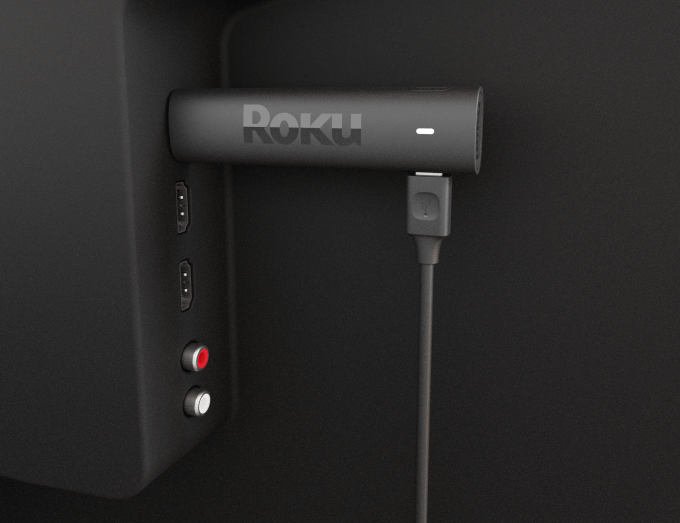
Image Credits: Roku
Both versions of the Streaming Stick will be sold online and in stores starting in October.
The Roku Ultra LT ($79.99), built for Walmart exclusively, has also been refreshed with a faster processor, more storage, a new Wi-Fi radio with up to 50% longer range, support for Dolby Vision, Bluetooth audio streaming and a built-in ethernet port.
Plus, Roku notes that TCL will become the first device partner to use the reference designs it introduced at CES for wireless soundbars, with its upcoming Roku TV wireless soundbar. This device connects over Wi-Fi to the TV and works with the Roku remote, and will arrive at major retailers in October where it will sell for $179.99.
The other big news is Roku’s OS 10.5 software release. The update isn’t making any dramatic changes this time around, but is instead focused largely on voice and mobile improvements.
The most noticeable consumer-facing change is the ability to add a new Live TV channel to your home screen, which lets you more easily launch The Roku Channel’s 200+ free live TV channels, instead of having to first visit Roku’s free streaming hub directly, then navigate to the Live TV section. This could make the Roku feel more like traditional TV for cord-cutters abandoning their TV guide for the first time.
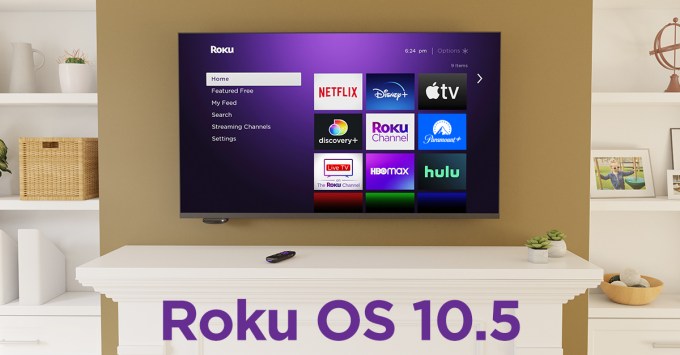
Image Credits: Roku
Other tweaks include expanded support for launching channels using voice commands, with most now supported; new voice search and podcast playback with a more visual “music and podcast” row and Spotify as a launch partner; the ability to control sound settings in the mobile app; an added Voice Help guide in settings; and additional sound configuration options for Roku speakers and soundbars (e.g. using the speaker pairs and soundbar in a left/center/right) or in full 5.1 surround sound system).
A handy feature for entering in email and passwords in set-up screens using voice commands is new, too. Roku says it sends the voice data off-device to its speech-to-text partner, and the audio is anonymized. Roku doesn’t get the password or store it, as it goes directly to the channel partner. While there are always privacy concerns with voice data, the addition is a big perk from an accessibility standpoint.
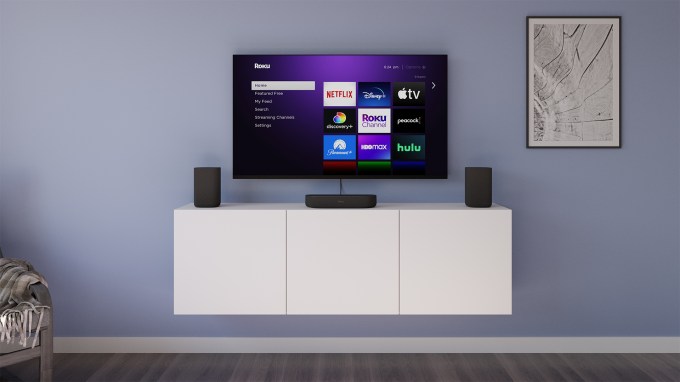
Image Credits: Roku
One of the more under-the-radar, but potentially useful changes coming in OS 10.5 is an advanced A/V sync feature that lets you use the smartphone camera to help Roku make further refinements to the audio delay when using wireless headphones to listen to the TV. This feature is offered through the mobile app.
The Roku mobile app in the U.S. is also gaining another feature with the OS 10.5 update with the addition of a new Home tab for browsing collections of movies and shows across genres, and a “Save List, which functions as a way to bookmark shows or movies you might hear about — like when chatting with friends — and want to remember to watch later when you’re back home in front of the TV.
The software update will roll out to Roku devices over the weeks ahead. It typically comes to Roku players first, then rolls out to TVs.
Powered by WPeMatico
While the technology and business world worked towards the weekend, developer operations (DevOps) firm GitLab filed to go public. Before we get into our time off, we need to pause, digest the company’s S-1 filing, and come to some early conclusions.
GitLab competes with GitHub, which Microsoft purchased for $7.5 billion back in 2018.
The company is notable for its long-held, remote-first stance, and for being more public with its metrics than most unicorns — for some time, GitLab had a November 18, 2020 IPO target in its public plans, to pick an example. We also knew when it crossed the $100 million recurring revenue threshold.
Considering GitLab’s more recent results, a narrowing operating loss in the last two quarters is good news for the company.
The company’s IPO has therefore been long expected. In its last primary transaction, GitLab raised $286 million at a post-money valuation of $2.75 billion, per Pitchbook data. The same information source also notes that GitLab executed a secondary transaction earlier this year worth $195 million, which gave the company a $6 billion valuation.
Let’s parse GitLab’s growth rate, its final pre-IPO scale, its SaaS metrics, and then ask if we think it can surpass its most recent private-market price. Sound good? Let’s rock.
GitLab intends to list on the Nasdaq under the symbol “GTLB.” Its IPO filing lists a placeholder $100 million raise estimate, though that figure will change when the company sets an initial price range for its shares. Its fiscal year ends January 31, meaning that its quarters are offset from traditional calendar periods by a single month.
Let’s start with the big numbers.
In its fiscal year ended January 2020, GitLab posted revenues of $81.2 million, gross profit of $71.9 million, an operating loss of $128.4 million, and a modestly greater net loss of $130.7 million.
And in the year ended January 31, 2021, GitLab’s revenue rose roughly 87% to $152.2 million from a year earlier. The company’s gross profit rose around 86% to $133.7 million, and operating loss widened nearly 67% to $213.9 million. Its net loss totaled $192.2 million.
This paints a picture of a SaaS company growing quickly at scale, with essentially flat gross margins (88%). Growth has not been inexpensive either — GitLab spent more on sales and marketing than it generated in gross profit in the past two fiscal years.
Powered by WPeMatico
As companies process ever-increasing amounts of data, moving it in real time is a huge challenge for organizations. Confluent is a streaming data platform built on top of the open source Apache Kafka project that’s been designed to process massive numbers of events. To discuss this, and more, Confluent CEO and co-founder Jay Kreps will be joining us at TC Sessions: SaaS on Oct 27th for a fireside chat.
Data is a big part of the story we are telling at the SaaS event, as it has such a critical role in every business. Kreps has said in the past the data streams are at the core of every business, from sales to orders to customer experiences. As he wrote in a company blog post announcing the company’s $250 million Series E in April 2020, Confluent is working to process all of this data in real time — and that was a big reason why investors were willing to pour so much money into the company.
“The reason is simple: though new data technologies come and go, event streaming is emerging as a major new category that is on a path to be as important and foundational in the architecture of a modern digital company as databases have been,” Kreps wrote at the time.
The company’s streaming data platform takes a multi-faceted approach to streaming and builds on the open source Kafka project. While anyone can download and use Kafka, as with many open source projects, companies may lack the resources or expertise to deal with the raw open source code. Many a startup have been built on open source to help simplify whatever the project does, and Confluent and Kafka are no different.
Kreps told us in 2017 that companies using Kafka as a core technology include Netflix, Uber, Cisco and Goldman Sachs. But those companies have the resources to manage complex software like this. Mere mortal companies can pay Confluent to access a managed cloud version or they can manage it themselves and install it in the cloud infrastructure provider of choice.
The project was actually born at LinkedIn in 2011 when their engineers were tasked with building a tool to process the enormous number of events flowing through the platform. The company eventually open sourced the technology it had created and Apache Kafka was born.
Confluent launched in 2014 and raised over $450 million along the way. In its last private round in April 2020, the company scored a $4.5 billion valuation on a $250 million investment. As of today, it has a market cap of over $17 billion.
In addition to our discussion with Kreps, the conference will also include Google’s Javier Soltero, Amplitude’s Olivia Rose, as well as investors Kobie Fuller and Casey Aylward, among others. We hope you’ll join us. It’s going to be a thought-provoking lineup.
Buy your pass now to save up to $100 when you book by October 1. We can’t wait to see you in October!
Powered by WPeMatico
APIs are the grease turning the gears and wheels for many organizations’ IT systems today, but as APIs grow in number and use, tracking how they work (or don’t work) together can become complex and potentially critical if something goes awry. Now, a startup that has built an innovative way to help with this is announcing some funding after getting traction with big enterprises adopting its approach.
Tyk, which has built a way for users to access and manage multiple internal enterprise APIs through a universal interface by way of GraphQL, has picked up $35 million, an investment that it will be using both for hiring and to continue enhancing and expanding the tools that it provides to users. Tyk has coined a term describing its approach to managing APIs and the data they produce — “universal data graph” — and today its tools are being used to manage APIs by some 10,000 businesses, including large enterprises like Starbucks, Societe Generale and Domino’s.
Scottish Equity Partners led the round, with participation also from MMC Ventures — its sole previous investor from a round in 2019 after boostrapping for its first five years. The startup is based out of London but works in a very distributed way — one of the co-founders is living in New Zealand currently — and it will be hiring and growing based on that principle, too. It has raised just over $40 million to date.
Tyk (pronounced like “tyke”, meaning small/lively child) got its start as an open source side project first for co-founder Martin Buhr, who is now the company’s CEO, while he was working elsewhere, as a “load testing thing,” in his words.
The shifts in IT toward service-oriented architectures, and building and using APIs to connect internal apps, led him to rethink the code and consider how it could be used to control APIs. Added to that was the fact that as far as Buhr could see, the API management platforms that were in the market at the time — some of the big names today include Kong, Apigee (now a part of Google), 3scale (now a part of RedHat and thus IBM), MuleSoft (now a part of Salesforce) — were not as flexible as his needs were. “So I built my own,” he said.
It was built as an open source tool, and some engineers at other companies started to use it. As it got more attention, some of the bigger companies interested in using it started to ask why he wasn’t charging for anything — a sure sign as any that there was probably a business to be built here, and more credibility to come if he charged for it.
“So we made the gateway open source, and the management part went into a licensing model,” he said. And Tyk was born as a startup co-founded with James Hirst, who is now the COO, who worked with Buhr at a digital agency some years before.
The key motivation behind building Tyk has stayed as its unique selling point for customers working in increasingly complex environments.
“What sparked interest in Tyk was that companies were unhappy with API management as it exists today,” Buhr noted, citing architectures using multiple clouds and multiple containers, creating more complexity that needed better management. “It was just the right time when containerization, Kubernetes and microservices were on the rise… The way we approach the multi-data and multi-vendor cloud model is super flexible and resilient to partitions, in a way that others have not been able to do.”
“You engage developers and deliver real value and it’s up to them to make the choice,” added Hirst. “We are responding to a clear shift in the market.”
One of the next frontiers that Tyk will tackle will be what happens within the management layer, specifically when there are potential conflicts with APIs.
“When a team using a microservice makes a breaking change, we want to bring that up and report that to the system,” Buhr said. “The plan is to flag the issue and test against it, and be able to say that a schema won’t work, and to identify why.”
Even before that is rolled out, though, Tyk’s customer list and its growth speak to a business on the cusp of a lot more.
“Martin and James have built a world-class team and the addition of this new capital will enable Tyk to accelerate the growth of its API management platform, particularly around the GraphQL focused Universal Data Graph product that launched earlier this year,” said Martin Brennan, a director at SEP, in a statement. “We are pleased to be supporting the team to achieve their global ambitions.”
Keith Davidson, a partner at SEP, is joining the Tyk board as a non-executive director with this round.
Powered by WPeMatico
Tile, the maker of Bluetooth-powered lost item finder beacons and, more recently, a staunch Apple critic, announced today it has raised $40 million in non-dilutive debt financing from Capital IP. The funding will be put toward investment in Tile’s finding technologies, ahead of the company’s plan to unveil a new slate of products and features that the company believes will help it to better compete with Apple’s AirTags and further expand its market.
The company has been a longtime leader in the lost item finder space, offering consumers small devices they can attach to items — like handbags, luggage, bikes, wallets, keys and more — which can then be tracked using the Tile smartphone app for iOS or Android. When items go missing, the Tile app leverages Bluetooth to find the items and can make them play a sound. If the items are further afield, Tile taps into its broader finding network consisting of everyone who has the app installed on their phone and other access points. Through this network, Tile is able to automatically and anonymously communicate the lost item’s location back to its owner through their own Tile app.

Image Credits: Tile
Tile has also formed partnerships focused on integrating its finding network into over 40 different third-party devices, including those across audio, travel, wearables and PC categories. Notable brand partners include HP, Dell, Fitbit, Skullcandy, Away, Xfinity, Plantronics, Sennheiser, Bose, Intel and others. Tile says it’s seen 200% year-over-year growth on activations of these devices with its service embedded.
To date, Tile has sold more than 40 million devices and has over 425,000 paying customers — a metric it’s revealing for the first time. It doesn’t disclose its total number of users, both free and paid combined, however. During the first half of 2021, Tile says revenues increased by over 50%, but didn’t provide hard numbers.
While Tile admits that the COVID-19 pandemic had some impacts on international expansions, as some markets have been slower to rebound, it has still seen strong performance outside the U.S., and considers that a continued focus.
The pandemic, however, hasn’t been Tile’s only speed bump.
When Apple announced its plans to compete with the launch of AirTags, Tile went on record to call it unfair competition. Unlike Tile devices, Apple’s products could tap into the iPhone’s U1 chip to allow for more accurate finding through the use of ultra-wideband technologies available on newer iPhone models. Tile, meanwhile, has plans for its own ultra-wideband-powered device, but hadn’t been provided the same access. In other words, Apple gave its own lost item finder early, exclusive access to a feature that would allow it to differentiate itself from the competition. (Apple has since announced it’s making ultra-wideband APIs available to third-party developers, but this access wasn’t available from day one of AirTag’s arrival.)

Image Credits: Tile internal concept art
Tile has been vocal on the matter of Apple’s anti-competitive behavior, having testified in multiple congressional hearings alongside other Apple critics, like Spotify and Match. As a result of increased regulatory pressure, Apple later opened up its Find My network to third-party devices, in an effort to placate Tile and the other rivals its AirTags would disadvantage.
But Tile doesn’t want to route its customers to Apple’s first-party app — it intends to use its own app in order to compete based on its proprietary features and services. Among other things, this includes Tile’s subscriptions. A base plan is $29.99 per year, offering features like free battery replacement, smart alerts and location history. A $99.99 per year plan also adds insurance of sorts — it pays up to $1,000 per year for items it can’t find. (AirTag doesn’t do that.)
Despite its many differentiators, Tile faces steep competition from the ultra-wideband-capable AirTags, which have the advantage of tapping into Apple’s own finding network of potentially hundreds of millions of iPhone owners.
However, Tile CEO CJ Prober — who joined the company in 2018 — claims AirTag hasn’t impacted the company’s revenue or device sales.
“But that doesn’t take away from the fact that they’re making things harder for us,” he says of Apple. “We’re a growing business. We’re winning the hearts and minds of consumers… and they’re competing unfairly.”
“When you own the platform, you shouldn’t be able to identify a category that you want to enter, disadvantage the incumbents in that category, and then advantage yourself — like they did in our case,” he adds.
Tile is preparing to announce an upcoming product refresh that may allow it to better take on the AirTag. Presumably, this will include the pre-announced ultra-wideband version of Tile, but the company says full details will be shared next week. Tile may also expand its lineup in other ways that will allow it to better compete based on look and feel, size and shape, and functionality.
Tile’s last round of funding was $45 million in growth equity in 2019. Now it’s shifted to debt. In addition to new debt financing, Tile is also refinancing some of its existing debt with this fundraise, it says.
“My philosophy is it’s always good to have a mix of debt and equity. So some amount of debt on the balance sheet is good. And it doesn’t incur dilution to our shareholders,” Prober says. “We felt this was the right mix of capital choice for us.”
The company chose to work with Capital IP, a group it’s had a relationship with over the last three years, and who Tile had considered bringing on as an investor. The group has remained interested in Tile and excited about its trajectory, Prober notes.
“We are excited to partner with the Tile team as they continue to define and lead the finding category through hardware and software-based innovations,” said Capital IP’s Managing Partner Riyad Shahjahan, in a statement. “The impressive revenue growth and fast-climbing subscriber trends underline the value proposition that Tile delivers in a platform-agnostic manner, and were a critical driver in our decision to invest. The Tile team has an ambitious roadmap ahead and we look forward to supporting their entry into new markets and applications to further cement their market leadership,” he added.
Powered by WPeMatico
Fortnite maker Epic Games is appealing last week’s ruling in its court battle with Apple, where a federal judge said Apple would no longer be allowed to block developers from adding links to alternative payment mechanisms, but stopped short of dubbing Apple a monopolist. The latter would have allowed Epic Games to argue for alternative means of serving its iOS user base, including perhaps, through third-party app stores or even sideloading capabilities built into Apple’s mobile operating system, similar to those on Google’s Android OS.
Apple immediately declared the court battle a victory, as the judge had agreed with its position that the company was “not in violation of antitrust law” and had also deemed Apple’s success in the app and gaming ecosystem as “not illegal.” Epic Games founder and CEO Tim Sweeney, meanwhile, said the ruling was not a win for either developers or consumers. On Twitter, he hinted that the company may appeal the decision when he said, “We will fight on.”
In a court filing published on Sunday (see below), Epic Games officially stated its attention to appeal U.S. District Judge Yvonne Gonzalez Rogers’ final judgment and “all orders leading to or producing that judgment.”
As part of the judge’s decision, Epic Games had been ordered to pay Apple the 30% of the $12 million it earned when it introduced its alternative payment system in Fortnite on iOS, which was then in breach of its legal contract with Apple.
The appellate court will revisit how Judge Gonzalez Rogers defined the market where Epic Games had argued Apple was acting as a monopolist. Contrary to both parties’ wishes, Gonzalez Rogers defined it as the market for “digital mobile gaming transactions” specifically. Though an appeal may or may not see the court shifting its opinion in Epic Games’ favor, a new ruling could potentially help to clarify the vague language used in the injunction to describe how Apple must now accommodate developers who want to point their customers to other payment mechanisms.
So far, the expectation floating around the developer community is that Apple will simply extend the “reader app” category exception to all non-reader apps (apps that provide access to purchased content). Apple recently settled with a Japanese regulator by agreeing to allow reader apps to point users to their own website where users could sign up and manage their accounts, which could include customers paying for subscriptions — like Netflix or Spotify subscriptions, for instance. Apple said this change would be global.
In briefings with reporters, Apple said the details of the injunction issued with the Epic Games ruling, however, would still need to be worked out. Given the recency of the decision, the company has not yet communicated with developers on how this change will impact them directly nor has it updated its App Store guidelines with new language.
Reached for comment, Epic Games said it does not have any further statements on its decision to appeal at this time.
Powered by WPeMatico
Media technology company Amagi announced Friday $100 million to further develop its cloud-based SaaS technology for broadcast and connected televisions.
Accel, Avataar Ventures and Norwest Venture Partners joined existing investor Premji Invest in the funding round, which included buying out stakes held by Emerald Media and Mayfield Fund. Nadathur Holdings continues as an existing investor. The latest round gives Amagi total funding raised to date of $150 million, Baskar Subramanian, co-founder and CEO of Amagi, told TechCrunch.
Bangalore-based Amagi provides cloud broadcast and targeted advertising software so that customers can create content that can be created and monetized to be distributed via broadcast TV and streaming TV platforms like The Roku Channel, Samsung TV Plus and Pluto TV. The company already supports more than 2,000 channels on its platform across over 40 countries.
“Video is a complex technology to manage — there are large files and a lot of computing,” Subramanian said. “What Amagi does is enable a content owner with zero technology knowledge to simplify that complex workflow and scalable infrastructure. We want to make it easy to plug in and start targeting and monetizing advertising.”
As a result, Amagi customers see operational cost savings on average of up to 40% compared to traditional delivery models and their ad impressions grow between five and 10 times.
The new funding comes at a time when the company is experiencing rapid growth. For example, Amagi grew 30 times in the United States alone over the past few years, Subramanian said. Amagi commands an audience of over 2 billion people, and the U.S. is its largest market. The company also sees growth potential in both Latin America and Europe.
In addition, in the last year, revenue grew 136%, while new customer year over year growth was 44%, including NBCUniversal — Subramanian said the Tokyo Olympics were run on Amagi’s platform for NBC, USA Today and ABS-CBN.
As more of a shift happens with video content being developed for connected television experiences, which he said is a $50 billion market, the company plans to use the new funding for sales expansion, R&D to invest in the company’s product pipeline and potential M&A opportunities. The company has not made any acquisitions yet, Subramanian added.
In addition to the broadcast operations in New Delhi, Amagi also has an innovation center in Bangalore and offices in New York, Los Angeles and London.
“Consumer behavior and infrastructure needs have reached a critical mass and new companies are bringing in the next generation of media, and we are a large part of that growth,” Subramanian said. “Sports will come on quicker, while live news and events are going to be one of the biggest growth areas.”
Shekhar Kirani, partner at Accel, said Amagi is taking a unique approach to enterprise SaaS due to that $50 billion industry shift happening in video content, where he sees half of the spend moving to connected television platforms quickly.
Some of the legacy players like Viacom and NBCUniversal created their own streaming platforms, where Netflix and Amazon have also been leading, but not many SaaS companies are enabling the transition, he said.
When Kirani met Subramanian five years ago, Amagi was already well funded, but Kirani was excited about the platform and wanted to help the company scale. He believes the company has a long tailwind because it is saving people time and enabling new content providers to move faster to get their content distributed.
“Amagi is creating a new category and will grow fast,” Kirani added. “They are already growing and doubling each year with phenomenal SaaS metrics because they are helping content providers to connect to any audience.
Powered by WPeMatico
Houseparty, the social video chat app acquired by Fortnite maker Epic Games for a reported $35 million back in 2019, is shutting down. The company says Houseparty will be discontinued in October when the app will stop functioning for its existing users; it will be pulled from the app stores today, however. Related to this move, Epic Games’ “Fortnite Mode” feature, which leveraged Houseparty to bring video chat to Fortnite gamers, will also be discontinued.
Founded in 2015, Houseparty offered a way for users to participate in group video chats with friends and even play games, like Uno, trivia, Heads Up and others. Last year, Epic Games integrated Houseparty with Fortnite, initially to allow gamers to see live feeds from friends while gaming, then later adding support to livestream gameplay directly into Houseparty. At the time, these integrations appeared to be the end goal that explained why Epic Games had bought the social startup in the first place.
Now, just over two years after the acquisition was announced, and less than half a year since support for livestreaming was added to the app, Houseparty is shutting down.
The company didn’t offer any solid insight into what, at first glance, feels like an admission of failure to capitalize on its acquisition. But the reality is that Epic Games may have something larger in store beyond just video chat. That said, all Epic Games would say today is that the Houseparty team could no longer give the app the attention it required — a statement that indicates an executive decision to shift the team’s focus to other matters.
While none of the Houseparty team members are being let go as a result of this move, we’re told, they will be joining other teams where they will work on new ways to allow for “social interactions” across the Epic Games family of products. The company’s announcement hinted that those social features would be designed and built at the “metaverse scale.”
The “metaverse” is an increasingly used buzzword that references a shared virtual environment, like those provided by large-scale online gaming platforms such as Fortnite, Roblox and others. Facebook, too, claims the metaverse is the next big gambit for social networking, with CEO Mark Zuckerberg having described it as an “embodied internet that you’re inside of rather than just looking at.”
To some extent, Fortnite has begun to embrace the metaverse by offering non-gaming experiences like online concerts you attend as your avatar, and other live events. Ahead of its shutdown, Houseparty also toyed with live events that users would co-watch and participate in alongside their friends.
An Epic Games spokesperson tells TechCrunch the Houseparty team has worked on (and continues to work on) a number of other projects that focus on social. But some of the “multiple, larger projects” Epic Games has in the works remain undisclosed, we’re told.
In terms of social products, Houseparty’s technology now underpins all of Fortnite voice chat and the features they built are widely available for free to developers through Epic Games Services. They also worked on building out new social experiences, which have ranged from the social RSVP functions for Fortnite’s global events, like the recent Ariana Grande concert, to the upcoming “Operation: Sky Fire” event for collaborating quests and other game mechanics. More social functionality and new experiences are also being built into Fortnite’s user-generated content platform, Create Mode.
While it may seem odd to close an app that only last year experienced a boost in usage due to the pandemic, it appears the COVID bump didn’t have staying power.
At the height of lockdowns, Houseparty had reported it had gained 50 million new sign-ups in a month’s time as users looked to video apps to connect with family and friends while the world was shut down. But as the pandemic wore on, other video chat experiences gained more ground. Zoom, which had established itself as an essential tool for remote work, became a tool for hanging out with friends after-hours, as well. Facebook also started to eat Houseparty’s lunch with its debut of drop-in video chat “Rooms” last year, which offered a similar group video experience. And bored users shifted to audio-based social networking on apps like Clubhouse or Twitter Spaces.
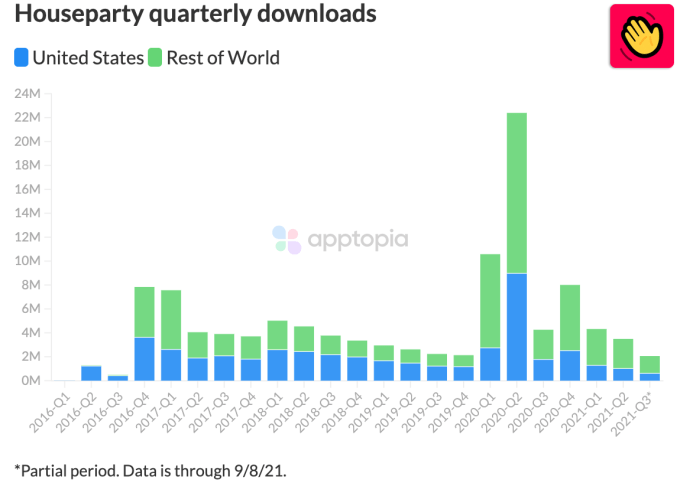
Image Credits: Apptopia
According to data from Apptopia, Houseparty has been continually declining since the pandemic bump. To date, its app has seen a total of 111 million downloads across iOS and Android, with the majority (63 million) on iOS. The U.S. was Houseparty’s largest market, accounting for 43.4% of downloads, followed by the U.K. (9.8%), then Germany (5.6%).
Epic Games, meanwhile, said the app served “tens of millions” of users worldwide. It insists the closure wasn’t decided lightly, nor was the decision to shutter “Fortnite Mode” made due to lack of adoption.
Houseparty will alert users to the shutdown via in-app notifications ahead of its final closure in October. At that point, Fortnite Mode will also no longer be available.
Powered by WPeMatico
Dispo, the photo-sharing app that emulates disposable cameras, started rolling out a test yesterday that will record user interest in selling photos as NFTs. Some users will now see a sell button on their photos, and when they tap it, they can sign up to be notified when the ability to sell Dispo photos launches.
CEO and co-founder Daniel Liss told TechCrunch that Dispo is still deciding how it will incorporate NFT sales into the app, which is why the platform is piloting a test with its users. Dispo doesn’t know yet what blockchain it would use, if it would partner with an NFT marketplace or what cut of sales Dispo would take.
“I think it’s safe to say from the test that there will be an experience native to the Dispo app,” Liss said. “There are a number of ways it could look — there could be a native experience within Dispo that then connects through an API to another platform, and in turn, they’re our partner, but to the community, it would look native to the Dispo app.”
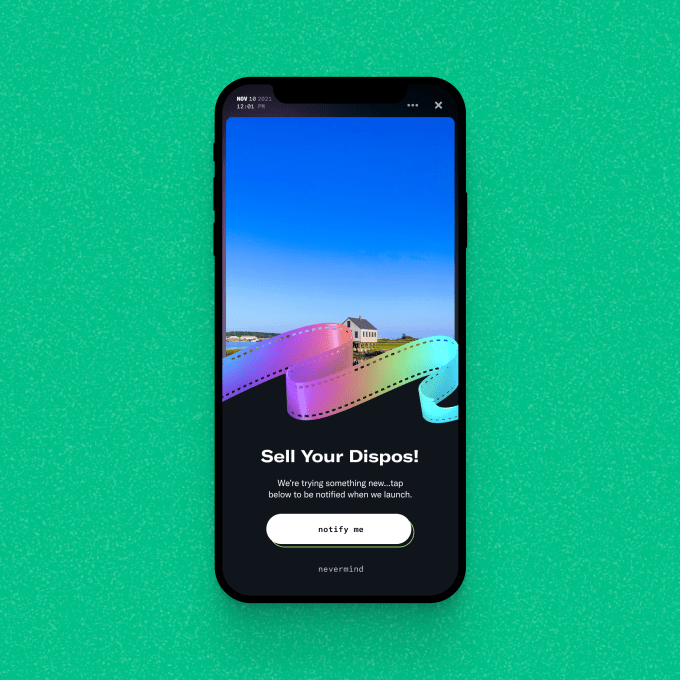
Image Credits: Dispo
This marks a new direction for the social media app, which seeks to redefine the photo-sharing experience by only letting users see the photos they took at 9 AM the next morning. From Dispo’s perspective, this gimmick helps users share more authentically, since you take one photo and then you’re done — the app isn’t conducive to taking dozens of selfies and posting the “best” image of yourself. But though it only launched in December 2019, Dispo has already faced both buzzy hype and devastating controversy.
Until about a year ago, the app was called David’s Disposables, named after co-founder and YouTuber David Dobrik. The app was downloaded over a million times in the first week after its release and hit No. 1 on the App Store charts. In March 2021, the app dropped its waitlist and relaunched with social network features, but just weeks later, Insider reported sexual assault allegations against a member of Vlog Squad, Dobrik’s YouTube prank ensemble. In response, Spark Capital severed ties with the company, leading to Dobrik’s departure. Other investors like Seven Seven Six and Unshackled Ventures, which contributed to the company’s $20 million Series A round, announced that they would donate any profits from their investments in Dispo to organizations working with survivors of sexual assault.
Liss told TechCrunch in June, when the company confirmed its Series A, that Dobrik’s role with the company was as a marketing partner — Liss has been CEO since the beginning. In light of the controversy, Liss said the app focused on improving the product itself and took a step back from promotion.
According to data from the app analytics firm SensorTower, Dispo has reached an estimated 4.7 million global installs to date since launch. Though the app saw the most downloads in January 2020, when it was installed over 1 million times, the app’s next best month came in March 2021, when it removed its waitlist — that month, about 616,000 people downloaded Dispo. Between March and the end of August, the app was downloaded around 1.4 million times, which is up 118% year over year compared to the same time frame in 2020 — but it should be expected that this year’s numbers would be higher, since last year, the app’s membership was exclusive.

Image Credits: Dispo
Now, with the announcement that Dispo is pursuing NFTs, Liss hopes that his company won’t just change how people post photos, but what the relationship will be between platforms and the content that users create.
“Why NFTs? The most powerful memories of our lives have value. And they have economic value, because we created them, and the past of social media fails to recognize that,” Liss told TechCrunch. “As a result, the only way that a creator with a big following is compensated is by selling directly to a brand, as opposed to profiting from the content itself.”
Adding NFT sales to the app offers Dispo a way to profit from a cut of user sales, but it stands to question how adding NFT sales could impact the community-focused feel of Dispo.
“I think there is tremendous curiosity and interest,” Liss said. “But these problems and questions are why we need more data.”
Powered by WPeMatico
A number of Spotify playlist curators are complaining that the streaming music company is not addressing the ongoing issue of playlist abuse, which sees bad actors reporting playlists that have gained a following in order to give their own playlists better visibility. Currently, playlists created by Spotify users can be reported in the app for a variety of reasons — like sexual, violent, dangerous, deceptive or hateful content, among other things. When a report is submitted, the playlist in question will have its metadata immediately removed, including its title, description and custom image. There is no internal review process that verifies the report is legitimate before the metadata is removed.
Bad actors have learned how to abuse this system to give themselves an advantage. If they see a rival playlist has more users than their own, they will report their competitors in hopes of giving their playlist a more prominent ranking in search results.
According to the curators affected by this problem, there is no limit to the number of reports these bad actors can submit, either. The curators complain that their playlists are being reported daily, and often multiple times per day.
The problem is not new. Users have been complaining about playlist abuse for years. A thread on Spotify’s community forum about this problem is now some 30 pages deep, in fact, and has accumulated over 330 votes. Victims of this type of harassment have also repeatedly posted to social media about Spotify’s broken system to raise awareness of the problem more publicly. For example, one curator last year noted their playlist had been reported over 2,000 times, and said they were getting a new email about the reports nearly every minute. That’s a common problem and one that seems to indicate bad actors are leveraging bots to submit their reports.
Many curators say they’ve repeatedly reached out to Spotify for help with this issue and were given no assistance.
Curators can only reply to the report emails from Spotify to appeal the takedown, but they don’t always receive a response. When they ask Spotify for help with this issue, the company only says that it’s working on a solution.
While Spotify may suspend the account that abused the system when a report is deemed false, the bad actors simply create new accounts to continue the abuse. Curators on Spotify’s community forums suggested that an easy fix to the bot-driven abuse would be to restrict accounts from being able to report playlists until their accounts had accumulated 10 hours of streaming music or podcasts. This could help to ensure they were a real person before they gained permission to report abuse.
One curator, who maintains hundreds of playlists, said the problem had gotten so bad that they created an iOS app to continually monitor their playlists for this sort of abuse and to reinstate any metadata once a takedown was detected. Another has written code to monitor for report emails and uses the Spotify API to automatically fix their metadata after the false reports. But not all curators have the ability to build an app or script of their own to deal with this situation.
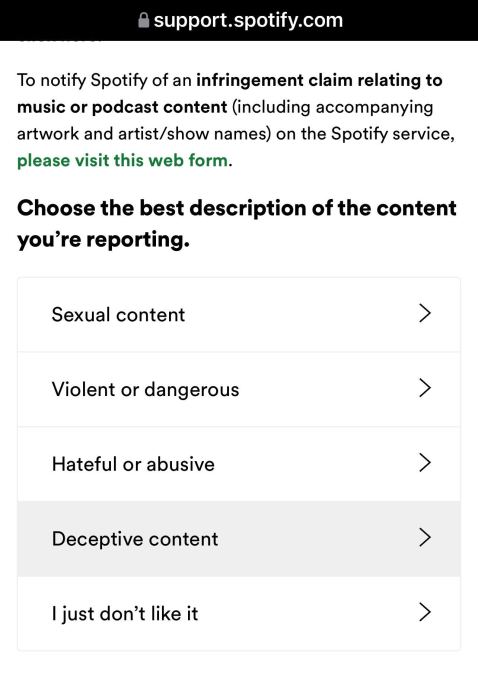
Image Credits: Spotify (screenshot of reporting flow)
TechCrunch asked Spotify what it planned to do about this problem, but the company declined to provide specific details.
“As a matter of practice, we will continue to disable accounts that we suspect are abusing our reporting tool. We are also actively working to enhance our processes to handle any suspected abusive reports,” a Spotify spokesperson told us.
The company said it is currently testing several different improvements to the process to curb the abuse, but would not say what those tests may include, or whether tests were internal or external. It could not provide any ballpark sense of when its reporting system would be updated with these fixes, either. When pressed, the company said it doesn’t share details about specific security measures publicly as a rule, as doing so could make abuse of its systems more effective.
Often, playlists are curated by independent artists and labels who are looking to promote themselves and get their music discovered, only to have their work taken down immediately, without any sort of review process that could sort legitimate reports from bot-driven abuse.
Curators complain that Spotify has been dismissing their cries for help for far too long, and Spotify’s vague and non-committal response about a coming solution only validates those complaints further.
Powered by WPeMatico